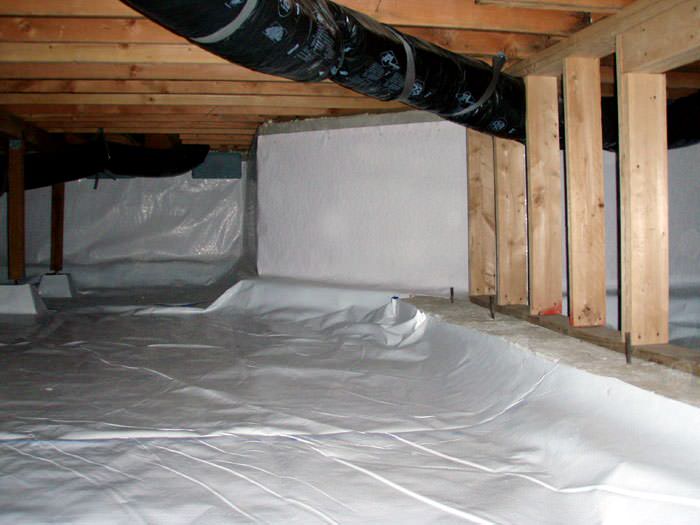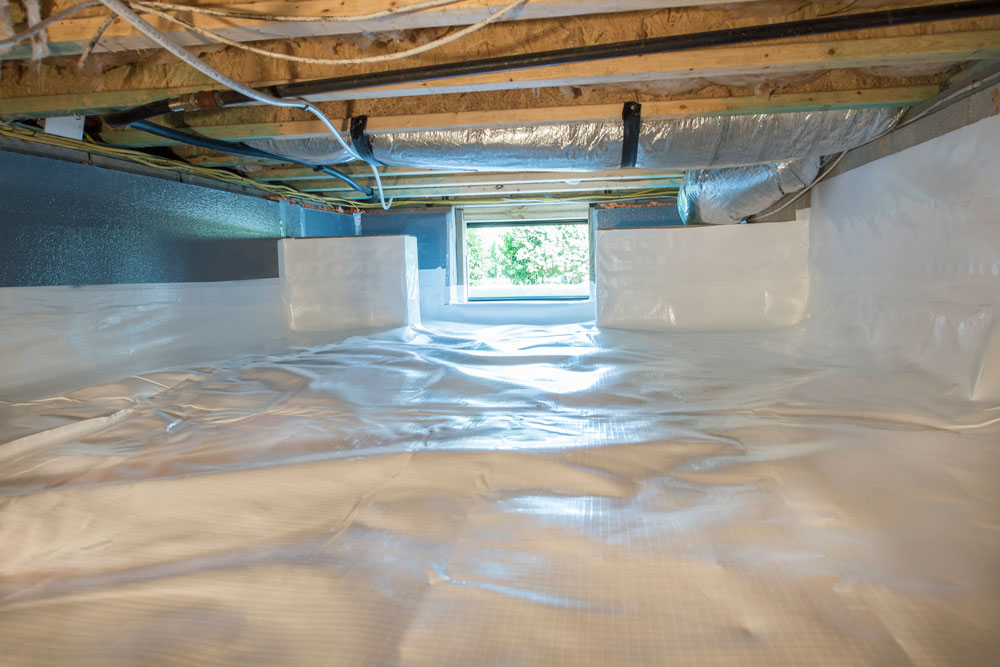For homeowners, keeping a clean and healthy crawl space is essential to avoid structural damage, mold growth, and pest infestations. Also, it helps to properly circulate air from the space, reducing energy costs and improving indoor air quality. But how exactly do you go about cleaning a crawl space?
This guide will provide step-by-step instructions for cleaning and maintaining your crawl space. From proper ventilation to efficient cleaning techniques, we’ll help you get the job done right. Let’s get started.
Common Maintenance Problems Of Crawl Space
Before you can start cleaning your crawl space, it is important to understand the root cause of its uncleanliness. Common problems that often lead to a need for crawl space cleaning include:
- Fungus and mold growth due to moisture or humidity build-up from inadequate ventilation or drainage systems. Fungal spores are dangerous as they can irritate airways and cause respiratory issues.
- The presence of animals such as rats, snakes, spiders, and other pests can lead to contamination, a breeding ground for parasites or diseases that can be harmful to humans.
- Hantavirus is a pathogen carried by rodents and their droppings, which can contaminate the air in your crawl space and cause illness in humans if inhaled.
- Poor insulation, air leaks, or inadequate ventilation can result in energy waste and higher energy bills.
- Damaged wiring due to corrosion or pests can be a fire hazard.
- Structural collapse due to wear and tear or damage over time can compromise the integrity of your home.
- Asbestos is often found in older insulation material and can be a health hazard if disturbed.
Steps To Clean Your Own Crawl Space
Maintaining a healthy and safe living environment is important to clean your crawl space regularly. Here are the steps you need to take for successful cleaning:
1. Crawl Space Inspection
Start by inspecting the crawl space for any signs of damage, water leakage, or pest infestation. Check for any loose wiring and damaged insulation as well. Inspect the air ducts and vents for any potential blockages or obstructions. Also, look for any signs of mold or mildew in the area.
2. Remove All Debris
Once you’re done inspecting, remove all the debris and dirt from the space using a vacuum cleaner to eliminate all dust particles and cobwebs. Use a broom or brush to sweep away any remaining debris and dirt. For more stubborn debris, use a dustpan and brush combo to get rid of it. Also, discard any excess material that is no longer useful.
3. Deal With Standing Water
If there is standing water or moisture, it’s best to deal with it as soon as possible. Use a wet/dry vacuum cleaner and mop up any standing water from the floors. Also, use a dehumidifier to reduce the humidity levels in the air and eliminate any further moisture. To prevent future water damage, ensure that all the plumbing and sump pump is checked and sealed where necessary.
4. Treat Any Pests or Mold
If there are pests, use an insecticide to get rid of them quickly and safely. If you find any mold in the area, use a bleach solution to thoroughly clean up the affected area. For more stubborn mold, consider using a professional service to clean it up. You should also ventilate the area with a fan to allow fresh air to circulate and prevent mold from reappearing.
5. Crawl Space Cleaning
Once all debris, pests, and mold have been removed, you can begin cleaning the crawl space. Start by vacuuming up any dirt or dust that has accumulated over time. Then, scrub down surfaces with a mild detergent to eliminate grime or grease. Use an air filter and vacuum cleaner to remove airborne particles and clean your crawl space.

6. Replace Old Insulation
If the insulation is old and damaged, it’s best to replace it. Choose a type of insulation appropriate for your climate and crawl space size. Common crawl space insulation materials include fiberglass, foam, and cellulose.
7. Crawl Space Encapsulation
The next step is to encapsulate the crawl space with a vapor barrier. This will help keep the moisture levels low and prevent mold from reappearing in the future. You can use plastic sheeting, foam board, or specialized liner products. This should be done with proper ventilation and a dehumidifier for best results.
8. Sealing Air Leaks
Make sure to seal any air leaks or cracks in the walls and floors. This can be done with a combination of caulk and foam spray insulation. Also, inspect any pipes and vents for potential air leaks. Doing so will help keep your crawl space well-insulated and prevent energy from escaping from the house. Also, a deodorizer or scented candles to help mask any odors.
9. Final Steps And Maintenance
Finally, make sure to clean up any mess that was created during the cleaning process. Use a wet/dry vacuum cleaner or mop to remove any remaining dirt and debris. Replace the filter in your air conditioner at least once every three months for optimal performance. It’s also important to periodically check all the seals and insulation materials to ensure they are still in good condition.
Do’s And Don’ts Of Crawl Space Cleaning
Cleaning a crawl space can be relatively straightforward with proper preparation and knowledge. However, there are some important do’s and don’ts to remember throughout the process.
Do: Determine Crawl Space Size And Accessibility
Before getting started, it’s important to understand the size and accessibility of your crawl space. Knowing how large your crawl space is can help determine what supplies are needed for the task. Additionally, understanding the area’s layout can save you time and energy throughout the cleaning process.
Don’t: Ignore Small Leaks
The area must stay dry for crawl spaces to be in optimal condition. If there are any leaks or cracks within the walls, it’s important to fix them immediately. Failing to do so can lead to more serious issues down the road.
Do: Repair The Damage
Any damaged materials or objects within the crawl space should be replaced and repaired as soon as possible. Pay close attention to check for any signs of mold, mildew, and other pests that might be present in the area. Also, repair any insulation that may be damaged.
Don’t: Neglect Ventilation
Crawl spaces require proper ventilation to stay dry and healthy. Inspect the area’s vents to ensure they’re functioning properly, and consider adding additional air ducts or fans if necessary. Also, ensure the vents are free of debris or dirt that might block airflow.
Do: Humidify The Space
Along with proper ventilation, it’s important to ensure the crawl space is not too humid. Humidity levels should remain consistent to prevent any damage to the area. Consider investing in a dehumidifier if needed.
Don’t: Use Water For Cleaning
Using too much water inside a crawl space can create more problems than it solves. When cleaning, only use dry methods such as vacuuming and sweeping to avoid introducing moisture into the area.
Do: Waterproofing
For added protection against moisture, consider waterproofing your crawl space. A quality sealant can help keep water out, and the area dries while preventing mold growth. Also, make sure to seal any cracks or openings in the walls.

Safety Considerations
Before you clean a crawl space, there are some safety considerations you must take into account.
- Ventilation: Ensure your crawl space is properly ventilated to avoid the accumulation of moisture, which can lead to mold and mildew buildup.
- Protection: Wear protective gear such as a dust mask, crawl space suit, safety glasses, and gloves when cleaning the crawl space.
- Equipment: Gather all necessary tools and materials before you begin cleaning. This may include brooms, mops, dust pans, buckets, and a vacuum cleaner.
- Structural Integrity: Check for any structural damage or weakened support beams that must be fixed before the crawl space cleaning process begins.
- Electrical Hazards: Turn off all power sources and check for signs of electrical hazards, such as frayed wiring, before entering the crawl space.
FAQs
1. What Are Crawl Space Cleaning Costs?
The crawl space cost for cleaning range can vary depending on the size of your crawl space and any contamination you may have. Generally, expect to pay between $400-$1000 for an average-sized crawl space cleanout. However, prices could be higher or lower depending on your specific needs. Also, if you have unique insulation, pipes, or wiring that needs to be removed and replaced, it may affect the final cost of crawl space cleaning.
2. Do I Need A Professional To Clean My Crawl Space?
It is best to use a professional for crawl space cleaning. Professionals have the experience and knowledge to remove any debris safely and assess if you need additional services such as insulation or waterproofing. For the safety of your family and the health of your home, it is best to use a professional for crawl space cleaning.
3. How Long Does Crawl Space Cleaning Take?
The length of time for crawl space cleaning will depend on the size of the area and any additional services you might need. However, most professionals can generally complete the job within a day or two.
4. What Should Be The Frequency Of Crawl Space Cleaning?
Your crawl space should be inspected once a year. If you notice any water damage, mold growth, or insect infestations in your crawl space, contact a professional as soon as possible to clean the area. Also, if you have had recent construction work done on your home or property that could affect the air quality of your crawl space, it is best to have the area inspected and cleaned.
5. Is It Necessary To Have The Crawl Space Cleaned?
Yes, it is important to periodically clean your crawl space as dirt and debris can accumulate over time. This debris can lead to poor air quality in the home, increase indoor allergens, and even cause mold growth. Also, if you notice insects or rodents inhabiting your crawl space, it will need to be cleaned and treated to avoid further issues.
6. What Is The Best Time To Have My Crawl Space Cleaned?
The best time to have your crawl space cleaned is in the early spring or late fall when temperatures are milder. This will allow the technician to work more efficiently and keep any debris, dirt, and dust from spreading around your home.
Conclusion
Crawl spaces can be a hassle to clean, but with the right tools and knowledge, it can be easy. Whether you do the job yourself or hire a professional, following these steps will ensure your crawl space is clean and free of contaminants.
Proper ventilation and insulation are important to help keep your crawl space healthy. A clean crawl space is one of the most effective ways to maintain healthy air quality in any home. Don’t let critters and dust bunnies take over your space. Clean it up and enjoy the fresh air!


